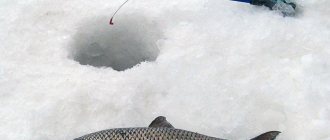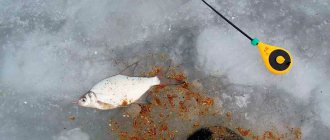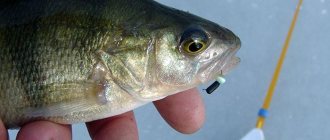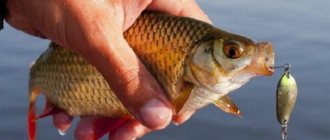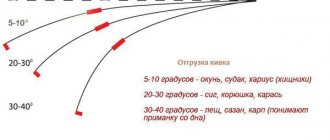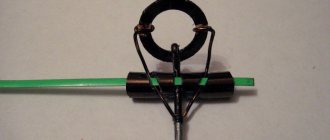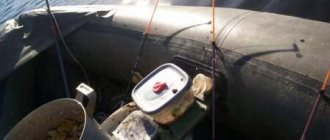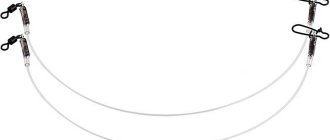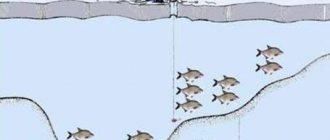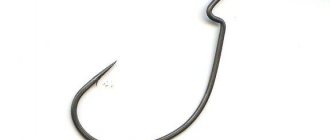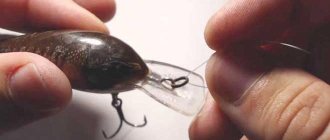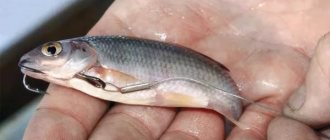Winter fishing is not as simple and monotonous as some people think. There are many fishing methods that are interesting and active in their own way. For example, fishing with a balancer is very unique - an artificial bait fish with which you can catch quite large predatory fish.
It is a bit like summer spin fishing. Only the fishing rod for ice fishing is much smaller and designed somewhat differently. For example, a nod for a balancer is a very sensitive bite alarm . It helps to see the approach of even the most sedentary fish. The design and options for such a gatehouse can be varied and even complex.
What does he look like
Most often this is a thin spring, a stick, a hair - anything that can have the ability to quickly respond to any tension on the fishing line , but at the same time have a certain margin of strength and elasticity. The material from which this gear is made must be frost-resistant and not freeze when water comes into contact with it at low temperatures.
At the same time, the guard, like all winter gear, should not be heavy - after all, the fisherman holds the rod in his hand all the time.
Making a gatehouse with your own hands
In past times, when there was not such a variety of materials and information on the topic, gatehouses were made from boar bristles or horsehair.
Nowadays, they are made from lavsan, x-ray film, plastic bottles and other available materials. Some people recommend purchasing hair from boar's mane or side bristles. This hair is resistant to low temperatures and has high elasticity.
Instructions
Made from boar bristles
From a clock spring
From rubber from nipple
This method is not very complicated, and also the oldest.
This manufacturing method has the following disadvantages:
But there is also an advantage:
Video instruction
The guard for the balancer has been made, all that remains is to check how it behaves in the water. To do this, use any container with water. If the test was successful, then you can go to the pond with it.
Need a nod or not?
There is still ongoing debate about whether a nod is needed for such a river hunt at all. Some enthusiasts are sure that a sensitive whip is enough - the basis of the fishing rod itself. In fact, when attacking the bait used by pike or zander, it is difficult not to notice a powerful bite. Moreover, when catching this fish, the fisherman often positions himself standing above the hole, so it is more convenient to catch a large and mobile specimen. You really can’t use a nod in such a situation.
Expert opinion
Knipovich Nikolai Mikhailovich
Zoologist, hydrobiologist. I am interested in fishing at a professional level.
Important! However, when fishing for smaller, slow-moving perch in cold water, the lack of a sensitive nod can cause a missed bite.
So the nod when sitting fishing above the hole is still more necessary than it is an extra tackle.
Manufacturing
It is necessary to cut off part of the ignition cable and insert it into the bearing, after first removing the wire core. Two cambrics are put on a wire or knitting needle, with a sinker between them. The dimensions of the cambric must ensure free movement of the sinker. If difficulties arise when moving the latter, you need to enlarge the hole using a drill of a suitable size.
To create a signal beacon, packaging foam or polystyrene foam is used. The cut out part is fixed on an awl and painted with bright varnish. The shape is limited only by the angler’s imagination; it can be cone-shaped, oval or square.
The bearing is secured to the axle using a soldering iron; to achieve better balancing, it is recommended to move the part closer to the opposite side of the spoke tip. As a result, the long lever must be balanced by the weight located in the middle of the short lever.
Next, the beacon is glued to the balancer lever with waterproof glue; the best option would be a cyanoacrylate compound.
The finished nod under the balancer is secured to the whip of the tackle. It is advisable that the fishing rod have a handle with a hole. It will be possible to place a counterweight in it if the balancer design turns out to be too heavy.
For fishing line, cambrics are fixed on the whip. The line is then passed through a hole on one side of the knitting needle and a sinker is attached. The position of the balancer changes depending on the buoyant force of the water surface and the hook with bait, and here the ability to move with cambrics comes in handy.
During a bite, the nod for the balancer on the pike raises the short side, equipped with a beacon. The bearing of the device requires systematic lubrication with automotive lithol or other suitable material.
Functions
As already mentioned, first of all, the guard is a bite indicator , as when fishing with a jig or bloodworm.
Another practical purpose of such a nod is that, with a slight twitch, it should provide the so-called game of bait , which imitates the behavior of a fry or small fish, which is bound to attract predatory fish.
This game depends not only on the movements of the fisherman (although you still need to learn how to imitate the behavior of a balancer in the water), but also on the material from which this tackle is made.
There are many store-bought options, but ice fishing veterans often prefer to make their own poles. The choice of materials today is quite diverse.
However, even industrial production nods can be quite catchy. You just need to choose them correctly.
Where can I buy?
A balancer guard is sold in almost any fishing store, especially in winter, when its relevance increases.
But we can also recommend you a number of trusted online stores:
Here you can purchase a balancer if it is not available in specialized stores in your locality.
The balancer guard is an extremely affordable product. Its price ranges from 10 to 100 rubles, depending on the material.
How to choose a gatehouse
The choice of such gear depends on many factors:
- from the fish that live in a given body of water;
- from the reservoir itself: from its depth and the presence of vegetation;
- from the current;
- from the weight of the balancer.
Each lodge has its pros and cons. Some amateurs prefer to take several species with them at once and determine on the spot which one is more catchy.
But there are adherents of one particular type of nod; they thoroughly study its features and use them to the fullest.
From a spring
Quite rational guards, have good sensitivity, are relatively inexpensive, but have a number of disadvantages:
- in the cold, when water gets in, the resulting ice particles stick to them;
- Over time, the spring stretches and loses its elasticity;
- Also, over time, such a nod simply rusts.
Lavsan
It has good sensitivity , but due to increased flexibility they are only suitable for light weight balancers. A significant disadvantage is fragility : during moving fishing, the fishing line quickly destroys the internal silicone tube.
To prevent this cut, some hobbyists insert a small metal ring .
From a metal plate
Such nods have the same positive properties as lavsan ones. But they are much stronger, so they can be used when fishing with large balancers.
The disadvantages include, perhaps, the relative complexity of self-production.
Combined
These gatehouses are made both from lavsan elements and using a metal plate. Usually these materials do not combine well, but in this case, high-quality industrially produced combined nods are quite reliable.
The disadvantage is the relatively high cost of the product .
Carbon fiber
Most often it is made independently from carbon whips. This type of nod has high plasticity and is frost-resistant, but it takes a long time to process.
Apparently, this is why there is practically no industrial production of such gatehouses, unlike whips.
Equipment
Fishing rod
If you use balancers of different sizes, then you need to have different fishing rods. It is enough to equip 3-4 different ones.
For small balancers (2-2.5 cm), a small fishing rod with an open reel with a diameter of 55 - 60 mm is more suitable.
For medium balancers (3-3.5 cm) - with an open coil with a diameter of 75 - 80 mm.
Larger balancers (4-5 cm) require the use of a fishing rod with an open reel with a diameter of 95 - 100 mm and a more powerful whip.
Many people have appreciated the advantages of spinning reels, especially at great depths or in windy weather.
The handle of any fishing rod should be made of a material with low thermal conductivity.
Nod for balancer
There is still debate about the advisability of installing a nod. Some anglers consider the presence of a nod to be an important condition for successful fishing, citing the fact that half of the bites, especially in the middle of winter, are very weak, cautious and barely noticeable even with the presence of a nod. It's hard to disagree with this. Another part of the fishing fraternity claims that the nod only complicates the work of the tackle.
When using a fishing rod with a sensitive whip, especially when actively biting on medium and large balancers, there is no need for a nod. And this is also true. And yet, as you already understood, under certain conditions a nod is necessary.
The length of the nod usually ranges from 60 to 100 mm. The profile is flat. Material – hard lavsan, or metal (clock spring, beryllium bronze), or a combination of both. Recently, silicone nods have appeared, combined from silicone and lavsan, nods with a six.
Photo 1. Dacron spring type nod.
Photo 2. Nod made of a metal plate.
Photo 3. Silicone nod.
Photo 4. Combined nod made of lavsan and silicone.
Photo 5. Nod with a six.
The lavsan construction provides good sensitivity, adjustability and high reliability of the nod. Such nods do not break or become deformed. The mounting sleeve must be made of frost-resistant rubber and securely fix the nod to the rod. For the balancer, nods made of hard lavsan are suitable. With such nods, light balancers are mainly used.
We invite you to familiarize yourself with the Apricot Memory of Shevchuk - description of the variety and reviews with photos
nods made of metal plate. They show a good bite, are not afraid of low temperatures and wind, but are easily deformed, especially at the point of attachment to the whip.
Combined nods have proven themselves well. They are made from the same lavsan and silicone. This nod consists of two parts. The one that is attached to the whip is made of silicone. It protects the lavsan plate from kinks and gives additional elasticity at the point of attachment to the whip.
Any nods must be adjustable in length. Practically do not react to side winds. It is good to record bites even in difficult weather conditions. Do not deform when bending. A nod, just like a spinning rod, must have a test that is indicated in grams, for example “8.0 - 16.0”
Requirements for winter fishing lines.
- should not be confused, i.e. should not be too soft;
- should not absorb water;
- should not stick to your hands;
- resistance to low temperatures (should not change its characteristics);
- the tensile strength must correspond to the expected load with a minimum thickness of the fishing line;
- knot strength.
Most winter fishing lines, which the manufacturer has specially adapted for such conditions, meet these requirements.
Table No. 1. Match the size of the balancer to the diameter of the fishing line.
| Balancer Length (cm) | Line diameter (mm) |
| 2-2,5 | 0,12-0,14 |
| 3-3,5 | 0,15 |
| 4-5 | 0,16 |
| 5,5-6 | 0,17 |
| 6,5-7,5 | 0,17-0,2 |
Particular attention should be paid to the diameter of the fishing line. Even a slight increase in diameter (by 0.01 mm) can worsen the performance of the balancer. Using a line that does not match the size of the balancer leads to noticeable failures and sometimes the termination of the performance of the balancer.
Fluorocarbon has proven itself well. Sometimes a clearly visible fluorescent fishing line helps to monitor the movement of the balancer. The use of “braid” in the vast majority of cases is not justified. The disadvantages include its inability to stretch, depreciate and, as a result, increase the number of derailments. In addition, it is more likely than monofilament to get tangled.
If you are purposefully catching a pike or there is a high probability of catching it while catching another predator, then it makes sense to use a leash. For blade balancers, especially large ones, it is not a big hindrance. The use of thick, rough leashes is unacceptable. It is better to use very thin tungsten with a diameter of 0.12-0.15 mm.
It should be borne in mind that adding a leash in some cases still has a negative effect on the balancer's play. And you shouldn’t use them on small baits at all. To some extent, using a “braid” with a diameter of 0.12-0.14 instead of a leash can be considered a compromise. In this case, biting occurs less frequently, although it still happens.
On bladeless balancers, leashes are either not installed at all, or a “braided line” is used, since the leash interferes with the ease of movement and complicates the delicacy of the bait. In my opinion, it’s better to lose one or two balancers and catch fish than to be left without a single bite. So decide for yourself whether to put a leash or not, depending on the situation.
We suggest you read How to grow at home
So we are fully armed. It's time to get to work! The long-awaited weekend has arrived. The snow crunches pleasantly under your feet. Now the ice screw is already biting into the ice with sharp knives... We lower a brand new balancer into the hole. At first, the new gear does not inspire confidence. Will it work? Now everything depends on game techniques, strategy and tactics.
Selecting a nod for a balancer
The nod is selected to match the weight of the balancer so that it does not bend too much, and at the same time, is sensitive. We pay attention to other factors:
- how well the line passes through it;
- check the flexibility of the product in the cold;
- when choosing between a silicone tube and electrical wire insulation, give preference to the first option, it is more flexible in the cold;
- when the nod is loaded, its deflection angle is permissible within 30-45 degrees; this is easy to check with a protractor;
- the color of the tackle should be bright so that any, even the slightest fluctuations are noticeable;
- nods for jigs are most often not suitable for fishing with a balancer; they cannot withstand the weight of the bait.
- and do not forget to check the strength of the nod on the whip, especially for homemade structures.
Do you need a nod when fishing with a balance beam?
With the development of modern materials, the need for the wholesale installation of nods on tackle for trolling is no longer necessary. The predatory fish bites quite hard, the bite is transmitted to the hand. Modern carbon fiber and graphite whips work out this point perfectly. With a clearly adjusted fishing rod (matching the weight of the bait, the thickness of the fishing line and the elasticity of the whip), an additional bite indicator is not needed. When using homemade rough gear, or old “wooden” gear, when the action is not felt by the fishing rod, the guard can help in fixing the bite.
The peculiarity of using nodding equipment is that a soft guard is required. A blank that in no way makes spring vibrations under the weight of the bait is suitable. In the working position under load, the nod should be almost completely bent.
When you equip light lure fishing rods with metal nods, then you get a very interesting process. If you put metal on the fishing rod. plate up to 0.08 millimeters thick, in this case, when the balancer is located in the lowest position, then the modification during the game with these guards can be very different from the same game with nipples.
Non-standard models
We have already talked about traditional nods, which are usually used for this type of fishing. Such models are simply put on the whip and serve as its continuation. But there are also more original and complex models.
Crossbow guard
The attractiveness of the design is that it creates virtually no resistance when biting. but creates a certain game for the bait.
The guard consists of a triangular wire structure with a twisted rubber band, onto which a silicone tube is placed. A regular nod is inserted into the cut into the tubes.
Shcherbakov's nod
It is called a balancer, but when fishing with a balancer it is practically not used, since it does not provide the action of the bait. The essence of the gear is unusual. The nod itself is mounted across the main rod on a bearing, the upper part of which is equipped with a tulip and fishing line, and a small weight or signaling device remains on the lower part. When biting, the upper part of the nod smoothly lowers with the assistance of the bearing.
Nod (guard) for the balancer - types, purpose, manufacturing instructions
In winter, fishing with the help of a balancer for various predators of the reservoir, including perch, is gaining increasing popularity among anglers. But some beginning fishing enthusiasts assume that catching fish with a balance beam is a very difficult process that requires a lot of experience in fishing and is also less catchy than fishing with a bloodworm jig. This opinion is wrong.
Perch is a fish that lives in schools and during one of the most active periods of feeding, its food is fry. It is the balancer that will help imitate the fry and thereby help in catching this fish.
How to do it yourself
It is necessary to sequentially manufacture the nod itself and the connector (holder) that will attach it to the fishing rod. The materials we need are scissors, a needle and a plastic mylar strip:
- the strip is made about 6 cm long;
- make it cone-shaped;
- On the thin side with a hot needle we make a hole for the fishing line.
Now let's start making the connector:
- take a two-core wire, cut off a piece of about 5-6 mm;
- from one part we remove the conductive core along with the insulation;
- from the other - only the core.
The hole of the larger diameter will be put on the rod of the fishing rod, and the fishing line will pass through the small one.
Is the bite unnoticeable? Making a balancing nod
Winter is approaching and for many fishermen this means the opening of the ice fishing season. In this matter you will need a good nod, especially when it comes to catching crucian carp. The fact is that in winter the crucian carp is quite sluggish and its bites are almost unnoticeable. They can manifest themselves in a short, instantaneous nod, which the fisherman may not notice; moreover, the crucian carp often raises the nod, which is also hard to see. Thanks to the inertia of the nod, you will immediately be able to clearly see that the fish has taken the bait.
Materials and tools for homemade work:
From materials:
- an umbrella knitting needle or a flat piece of steel wire; — a small bearing (suitable for a fishing reel or hard drive); — a piece of high-voltage ignition cable; - cambrics; — sliding sinker; - waterproof glue; - fluorescent varnish.
Tools:
- stationery knife; - soldering iron with all accessories; - awl; - pliers.
Nod making process:
Step one. Preparing the components
First of all, take the bearing, we need to prepare it so that it can be easily put on the tip of the winter fishing rod. To do this, you will need a piece of thick cambric, which can be obtained from a high-voltage car ignition cable. We cut off the required piece and insert it into the bearing core. For reliability, the elastic band can be coated with glue.
Next, take a knitting needle and a sliding sinker.
We adjust the hole in the sliding sinker so that the sinker slides freely along the knitting needle. You also need to put two pieces of cambric on the knitting needle, one in front of the sinker and one in the back. Step two. Making a signal beacon
In order for the nod to be clearly visible at a great distance, you need to make a beacon for it. Here you will need a small piece of polystyrene or foam rubber for packaging. Having cut off the required piece, we have to paint it. To do this, the author places a piece on an awl and then paints it with bright fluorescent paint.
As for the sizes, the author has a cube 1 cm wide. If you wish, you can make the beacon round, triangular, and so on.
Step three.
Gluing the structure At this stage it is necessary to glue the spoke to the bearing. Here you will need a good waterproof glue, the author uses cyanoacrylate-based glue, but hot glue will work just fine. We glue the knitting needle so that a lever is formed. The idea is that the weight on the short lever balances the long, heavy part.
Now all that remains is to attach the beacon to the lever; it is installed on the short part of the lever.
That's all, install the nod on the fishing rod. The task will be to adjust the nod so that it is in a horizontal position. Our weight is fixed with cambrics, so by moving them we establish the desired position of the weight relative to the center.
You will also need to glue cambrics to the fishing rod and to the bearing; the fishing line will pass through them.
How it all works
First of all, we pass the fishing line through the cambrics, and then through the ring at the end of the knitting needle. Having attached the hook, bait and everything you need, you will need to balance the nod, since the gear creates additional weight. We move the sinker forward/backward and select the horizontal position of the nod. That's it, we're waiting for the first bite! Now about the bites. Let's say a crucian carp swims up to the bait and makes even the slightest poke downwards. As a result, the long lever goes down and the beacon rises up.
If the crucian carp lifts the bait, the long part of the lever becomes lighter than the short part with the sinker and rises up. As a result, we will have a beacon below.
That's all, the nod is completely ready. With its help you can catch rotan crucian carp and other fish, which are distinguished by their caution and slowness.
One of the advantages of this design is that the beacons can be seen quite far away, which cannot be said about ordinary fishing rods. The disadvantages include the complexity of manufacturing, the difficulty of setting, as well as the problem with hooking. You need to hook with a long wave of your hand in order to compensate for the stroke of the lever.
Good luck and big catches!
Source
Become the author of the site, publish your own articles, descriptions of homemade products and pay for the text. Read more here.
